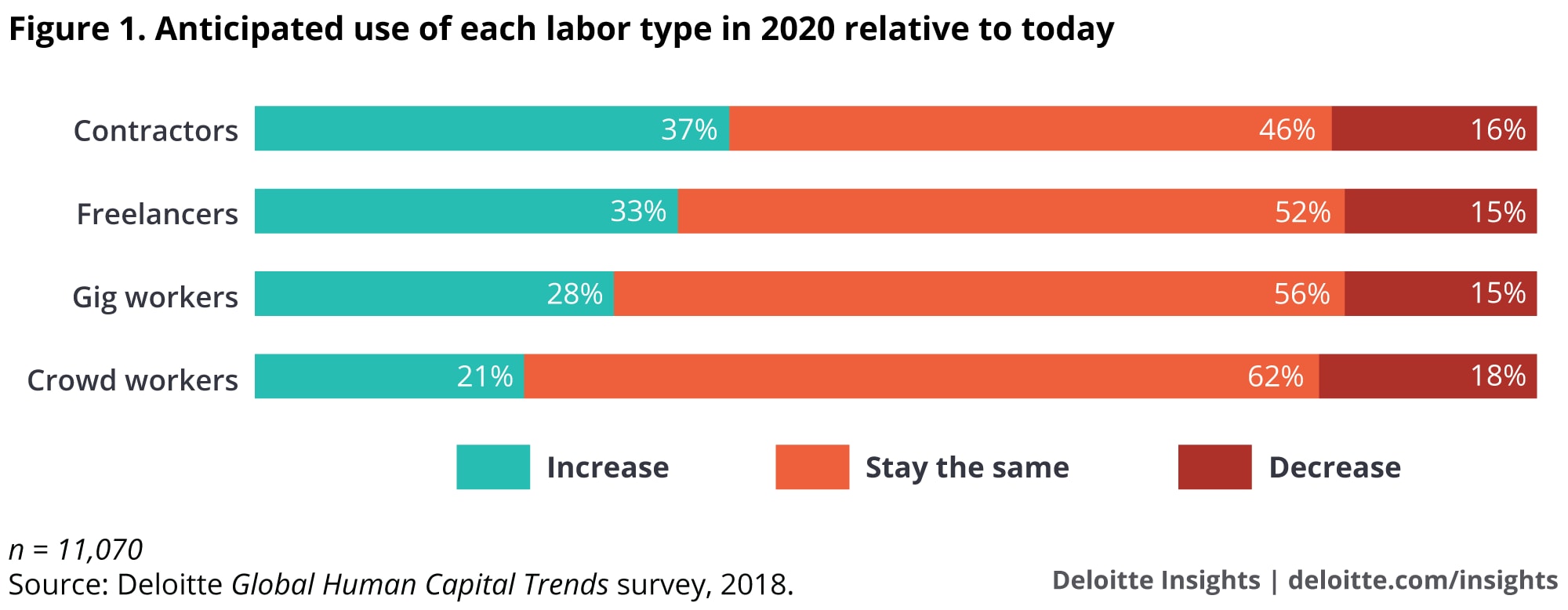
The workforce ecosystem: Managing beyond the enterprise 2018 Global Human Capital Trends
28 March 2018
The composition of the workforce is changing dramatically. As alternative work arrangements become more common, how can organizations appeal to, engage with, and drive value through workers of all different types?

A diverse talent ecosystem
Learn more
View 2018 Global Human Capital Trends
Watch the related videos for this trend: Fiverr, SAP America
Explore the infographic and watch the video
Download the full report or create a custom PDF
Learn how companies are redefining work
Today's workforce has become a dynamic ecosystem. Only 42 percent of this year’s survey respondents tell us that their organizations are primarily made up of salaried employees, and employers expect to dramatically increase their dependence on contract, freelance, and gig workers over the next few years. As alternative work arrangements become more common in the broader economy, HR and business leaders are rapidly trying to plan and optimize their own workforce ecosystems, pressured by the need to improve service, move faster, and find new skills.
The composition of the workforce is changing dramatically. Globally, there are approximately 77 million formally identified freelancers in Europe, India, and the United States.1 In the United States, more than 40 percent of workers are now employed in “alternative work arrangements,” such as contingent, part-time, or gig work.2 This percentage is steadily rising—increasing by 36 percent in just the past five years—and now includes workers of all ages and skill levels. 3 In this year’s Global Human Capital Trends survey, 50 percent of the year’s respondents reported a significant number of contractors in their workforces; 23 percent reported a significant number of freelancers, and 13 percent reported a significant number of gig workers.
All of this suggests that, in simplest terms, the traditional employer-employee relationship is being replaced by the emergence of a diverse workforce ecosystem—a varied portfolio of workers, talent networks, gig workers, and service providers that offers employers flexibility, capabilities, and the potential for exploring different economic models in sourcing talent.
While it may be appealing to hire contractors quickly or to outsource technical or service work, taking advantage of the emerging workforce ecosystem’s benefits brings a variety of new challenges, and our research shows that most companies are not fully ready. When asked to forecast the makeup of their workforce in 2020, 37 percent of this year’s survey respondents expected growth in the use of contractors, 33 percent in the use of freelancers, and 28 percent in the use of gig workers. But despite this anticipated growth, only 16 percent told us they have an established set of policies and practices to manage a variety of worker types, pointing to an enormous gap in capabilities.
Alternative work arrangements are on the rise
Respondents expect a substantial increase in their organizations’ use of contractors, freelancers, and gig workers over the next two years.

Explore the data further in the Global Human Capital Trends app.
The challenge is not just the tactical one of finding enough of the right people to execute particular tasks at particular times. To drive real value through the new workforce ecosystem, organizations need to understand how to appeal to and engage with workers of all kinds. And not all workers in this ecosystem have traditional views of what an employer-worker relationship should look like. Consider the common aspirations of millennials and Generation Z: A recent study found that 75 percent of workers in these generations plan to start their own business;4 more than 70 percent want their work to support their personal interests, and only 12 percent believe that an invention they create should belong to their employer.5
The challenges of managing the workforce ecosystem
Our interviews and survey data suggest that most non-traditional workers are managed tactically, often handled by the procurement department, with few consistent talent strategies in place. In this year’s Global Human Capital Trends survey, only 29 percent of respondents said that their organizations track these ecosystem workers’ compliance with work contracts, and only 32 percent track their quality of work.

The sheer variety of today’s work arrangements makes it hard to even understand what types of workers are employed, let alone manage them strategically. As shown in figure 2, the workforce ecosystem ranges from full-time workers to freelancers, gig workers, and crowds who focus on projects and tasks but may have little understanding of or interest in an organization’s overall strategy. Organizations may expect these workers to be well trained and ready to work, but in reality, they need support, guidance, and performance measures if an employer wants to optimize the entire mix.
Making things even more difficult is the fact that the HR software market has historically not built many tools to help employers manage non-traditional workers. Only in the last few years have vendors such as WorkMarket (just acquired by ADP) and Fieldglass (acquired by SAP in 2014), as well as startups such as RallyTeam, Fuel50, and others, started to offer contingent, gig, and project management tools to help companies manage and communicate with the broader workforce ecosystem.6 In most cases, once they see the problem as strategic, organizations build their own tools and apps to manage the most-used types of contingent workers.
That the problem is strategic is becoming beyond debate. Aside from the opportunity cost of failing to capitalize on alternative work arrangements, new workforce models can create legal, security, privacy, and other risks. For instance, more than one-third of our respondents (42 percent) worry about the loss of confidential information due to the use of contractors, and 36 percent are concerned about the reputational risk that could arise from a negative perception of non-traditional employees. Some 38 percent worry about the instability of a non-traditional workforce, and 39 percent worry about violations or changing government regulations in managing or categorizing these workers.
Engaging the workforce ecosystem
What can organizations do to engage these increasingly important ecosystem workers, even as they turn away from the very idea of being “employees”? Our research and experience point to several important components of success.
First, organizations should extend their talent management approaches to workers across the entire ecosystem. HR teams should work with legal and IT to give gig and contract workers clear performance goals, secure communication systems, and the right amount of training and support to make them productive and aligned with the company’s strategy. Cummins, for example, a global leader in power, energy systems, and engines, considers its contractors “a part of the family,” and tries to give them the same focus as full-time employees.7
Second, HR should get more involved in sourcing and selection decisions for alternative workers. Today, more than a third of our survey respondents say that HR is not involved in sourcing (39 percent) or hiring (35 percent) decisions for contract employees. This suggests that these workers are not subject to the cultural, skills, and other forms of assessments used for full-time employees. Since alternative workers can make up 30 to 40 percent of the workforce, organizations should carefully consider under what circumstances they should be screened like regular employees, if at all.
Third, organizations should provide ecosystem workers with onboarding and development opportunities. Perhaps because organizations fear these workers will become categorized as “full-time employees,” nearly half of the HR respondents to our survey (46 percent) say they are not involved in onboarding alternative workers, and more than half (55 percent) do not support training for this population. Again, this shows a lack of understanding of the workforce ecosystem’s importance. Most employers are currently treating alternative workers as unskilled labor, not as professionals.
Fourth, companies should consider workforce brand and incentive programs that cover the range of ecosystem workers. What can alternative workers do to make more money? What skills and capabilities should they develop? How will they be measured? HR should formalize these practices for the ecosystem rather than waiting for procurement to do it.
Success stories show the way
The challenges raised by the workforce ecosystem are all manageable, and companies can benefit from taking an integrated view of the problem. Consider a large pharmaceutical company whose in-house scientists had been struggling with a technical challenge for months. When the company engaged external talent for the problem, it found the solution in just six days.8
Businesses such as Fiverr, E-Lance, Doordash, and others have learned to manage contingent and gig workers. Many are growing at rapid rates while exploring approaches to improve alternative workers’ lives. A recent coalition led by Fiverr, Care.com, DoorDash, Etsy, Postmates, and others, working with Stride Health, has launched an initiative to help freelancers access health care programs and insurance in the United States.9 As freelancers, gig, and crowd workers become a growing proportion of the workforce, improving programs like these and integrating alternative and full-time workforces will grow in importance.
The bottom line
The growth of new workforce models is redefining the employer-worker relationship, and many organizations have the opportunity to draw upon today’s variegated labor market. HR and business leaders should proactively form new leadership alliances—especially between HR and procurement—to develop integrated workforce strategies and programs that can help an organization take advantage of the breadth of workforce options available today.

© 2021. See Terms of Use for more information.





